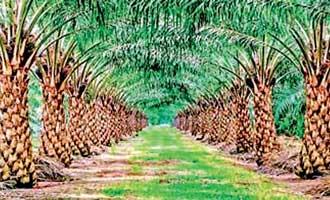Reply To:
Name - Reply Comment
By Nuzla Rizkiya
 Sri Lanka’s Palm Oil Industry Association (POIA) yesterday urged the government to make evidence-based decisions regarding the ongoing delay in lifting the ban on palm oil and allow the small-scale cultivations in specified areas.
Sri Lanka’s Palm Oil Industry Association (POIA) yesterday urged the government to make evidence-based decisions regarding the ongoing delay in lifting the ban on palm oil and allow the small-scale cultivations in specified areas.
POIA President Dr. Rohan Fernando highlighted the substantial socioeconomic benefits of palm oil, particularly in alleviating poverty among the smallholder farmers by capitalising the 40 percent Asian supply to meet the global demand.
He also cited the successful models adopted by Malaysia and Indonesia, which share a combined 15 million hectares of land for palm oil cultivation and effectively reaped the benefits of the plantation.
“In Sri Lanka, we talk about edible oils and the most suitable crops for our land. Unfortunately, decisions in this country have been made based on emotions and myths. That is why we are in this situation today,” Dr. Fernando stated.
“There should be evidence-based decisions. A country like Sri Lanka can truly benefit if palm oil is extended and expanded towards the smallholders. You don’t have to look too far to see Malaysia and Indonesia’s success story in palm oil cultivation for poverty alleviation,” he said while addressing a workshop organised by the Nucleus Foundation and Solidaridad on achieving food and nutrition security through
edible oils.
|
Dr. Rohan Fernando |
The ban on palm oil imports and oil palm cultivation was imposed in Sri Lanka following a sudden decision taken in April 2021 by the then President Gotabaya Rajapaksa, who announced the ban on new oil palm plantations and the uprooting of the existing ones.
The ban aimed to promote the consumption of coconut oil-based on the misconception that oil palm plantations have a higher water footprint and impacts the output of other crops nearby.
However, the water footprint for coconut oil cultivations was shown to be 10,548 m³ water/tonne, while for palm oil, the figure sits at 3,946 m³ water/tonne, according to a recent research study by Solidaridad, an international civil
society organisation.
Additionally, Sri Lanka spends a staggering Rs.57 million on importing vegetable oils, highlighting an urgent need to promote self-sufficiency, smallholder participation and investments in the local industry, according to the Nucleus Foundation.
The government too has been sitting on a decision to allow palm oil cultivation in certain identified Mahaweli and other areas, based on an expert committee report forwarded by the Agricultural Ministry to the Cabinet last January.
“In a country with limited land, productivity of each unit becomes paramount. Our experience shows that palm oil is the most productive, the most versatile and the one that brings poverty alleviation to our country. It’s only logical to grow what we can and prevent the outflow of foreign exchange,” Dr. Fernando stressed.
He went on the express confidence about the authorities heeding their call for evidence-based policies and a sustainable future for the palm
oil industry.
“We are confident that this very unfortunate ban will be lifted and that politicians, whoever is in power, will make evidence-based decisions. We hope this ban will soon be a thing of the past,” Dr. Fernando expressed.
According to the POIA, the current oil palm cultivation in Sri Lanka occupies a land space of 12,000 hectares. Moreover, Sri Lanka consumes 220,000 metric tonnes of palm oil, of which only 12 percent is produced locally.